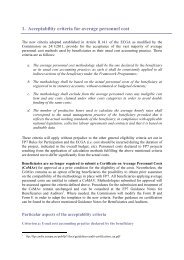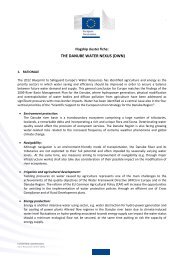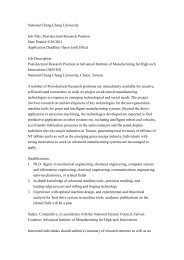Guide to Research and Innovation Strategies for Smart Specialisation
Guide to Research and Innovation Strategies for Smart Specialisation
Guide to Research and Innovation Strategies for Smart Specialisation
You also want an ePaper? Increase the reach of your titles
YUMPU automatically turns print PDFs into web optimized ePapers that Google loves.
Internationalisation<br />
Why should internationalisation be part of smart specialisation?<br />
Internationalisation is a crucial component of a S³ <strong>for</strong> at least three reasons:<br />
• The world is flat <strong>and</strong> all elements of an enterprise value chain can be located anywhere<br />
in the world through FDI or outsourcing.<br />
• The eco-system of Member States <strong>and</strong> Regions can be challenged by the eco-system of<br />
emerging countries. Today, even high added value elements of the enterprise value<br />
chain (i.e. R&D+I, support services, access <strong>to</strong> finance, design...) can be produced<br />
outside OECD countries. Regions have thus <strong>to</strong> benchmark themselves with any other<br />
regions <strong>to</strong> assess where the real or believed competitive advantages are challenged in<br />
order <strong>to</strong> permanently increase their values.<br />
• Internationalisation is becoming a more <strong>and</strong> more sophisticated context. It is much more<br />
than export <strong>and</strong> FDI. It is indeed also strategic alliances, joint research, co-development,<br />
outsourcing, relocation, mergers <strong>and</strong> acquisitions, licensing IPR, soft l<strong>and</strong>ing,<br />
technology showcase.<br />
Barriers <strong>and</strong> Challenges<br />
Internationalisation is about market <strong>and</strong> technology intelligence aiming at assessing if the<br />
smart specialisation strategy is able <strong>to</strong> resist <strong>to</strong> global competition or <strong>to</strong> take advantage of<br />
global competition opportunities (often niche markets).<br />
Many reports are showing that lots of SMEs do not use the full potential neither of the internal<br />
nor of the external market. Some of these reports indeed show that while 25% of EU-based<br />
SMEs are involved in export <strong>to</strong> the Internal Market, in the last three years only 13% of EU<br />
SMEs were internationally active outside the EU through trade or any other <strong>for</strong>ms of<br />
cooperation with <strong>for</strong>eign partners.<br />
According <strong>to</strong> a Finnish survey entitled 'International R&D in high growth SMEs –<br />
Implications <strong>to</strong> innovation policy' 110 , public authorities can help the internationalisation<br />
process of technological companies by supplying them with support services in the six areas<br />
below:<br />
• knowledge of international market <strong>and</strong> technology dem<strong>and</strong>,<br />
• strategy development <strong>for</strong> international R&D activities,<br />
• identification <strong>and</strong> selection of partners,<br />
• identification, selection <strong>and</strong> acquisition of technology,<br />
• skilled personnel,<br />
• funding <strong>for</strong> international core, close-<strong>to</strong>-market <strong>and</strong> supporting R&D.<br />
In some cases bold regional outsourcing or offshoring support policies should be deployed in<br />
order <strong>to</strong> help SMEs acquire components – including knowledge – at af<strong>for</strong>dable prices, thereby<br />
enabling them <strong>to</strong> remain competitive <strong>and</strong> hence ensure their long term survival. These days,<br />
there are definitely one or more good reasons <strong>to</strong> compare the expertise available in-house in<br />
110 Gaia Group, http://proact.ktm.fi/index.phtm?menu_id.<br />
92

















